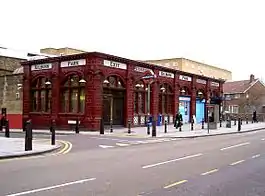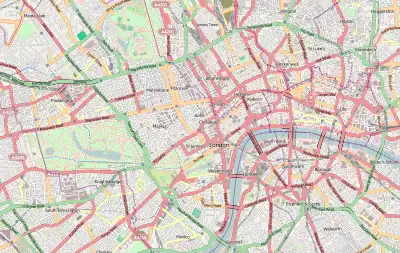| Kilburn Park | |
|---|---|
 | |
 Kilburn Park Location of Kilburn Park in Central London | |
| Location | Kilburn |
| Local authority | London Borough of Brent |
| Managed by | London Underground |
| Number of platforms | 2 |
| Fare zone | 2 |
| London Underground annual entry and exit | |
| 2018 | |
| 2019 | |
| 2020 | |
| 2021 | |
| 2022 | |
| Key dates | |
| 31 January 1915 | Opened |
| Listed status | |
| Listing grade | II |
| Entry number | 1078871[6] |
| Added to list | 15 March 1979 |
| Other information | |
| External links | |
| WGS84 | 51°32′06″N 0°11′39″W / 51.53512°N 0.19406°W |
Kilburn Park is a London Underground station at Kilburn in the London Borough of Brent. The station is on the Bakerloo line, between Queen's Park and Maida Vale stations, and is in Travelcard Zone 2.
The station is situated on Cambridge Avenue approximately 100 m west of Kilburn High Road, shortly before it becomes Maida Vale, (A5). It is Grade II listed.[6]
History
Kilburn Park was opened on 31 January 1915 as the temporary terminus of the Bakerloo line's extension from Paddington station towards Queen's Park.[7] Services were extended to Queen's Park on 11 February 1915.[7] At the extension's opening, Maida Vale station was not complete and the previous station was Warwick Avenue until 6 June 1915.[7] The station building was designed by Stanley Heaps in a modified version of the earlier Leslie Green designed Bakerloo line stations with glazed terra cotta façades but without the large semi-circular windows at first floor level. It was one of the first London Underground stations built specifically to use escalators rather than lifts.[lower-alpha 1]
It opened a short distance south of Kilburn High Road station which had previously handled much of the commuter traffic of the area, providing a quicker connection to the West End.
Transport links
Bus routes 31, 32, 206, 316, 328, school route 632 and night routes N28 and N31 serve the station. Also, it is only a short walk from Kilburn High Road Station (London Overground).
Gallery
 Ticket hall
Ticket hall Ticket window
Ticket window Glazed, domed roof over the escalators
Glazed, domed roof over the escalators The southbound platform
The southbound platform
Footnotes
- ↑ The first escalator on the Underground was installed at Earl's Court in 1911. The first station built specifically for escalators was the new Central line station at Liverpool Street in 1912. All deep-tube stations built after 1913 were built with escalators.[8]
References
- ↑ "Station Usage Data" (CSV). Usage Statistics for London Stations, 2018. Transport for London. 23 September 2020. Archived from the original on 14 January 2023. Retrieved 11 October 2023.
- ↑ "Station Usage Data" (XLSX). Usage Statistics for London Stations, 2019. Transport for London. 23 September 2020. Archived from the original on 9 November 2020. Retrieved 9 November 2020.
- ↑ "Station Usage Data" (XLSX). Usage Statistics for London Stations, 2020. Transport for London. 16 April 2021. Retrieved 1 January 2022.
- ↑ "Station Usage Data" (XLSX). Usage Statistics for London Stations, 2021. Transport for London. 12 July 2022. Retrieved 7 September 2022.
- ↑ "Station Usage Data" (XLSX). Usage Statistics for London Stations, 2022. Transport for London. 4 October 2023. Retrieved 10 October 2023.
- 1 2 Historic England. "Kilburn Park Underground Station (1078871)". National Heritage List for England. Retrieved 3 April 2015.
- 1 2 3 Rose, Douglas (1999). The London Underground, A Diagrammatic History. Douglas Rose/Capital Transport. ISBN 1-85414-219-4.
- ↑ Wolmar, Christian (2004). "Beginning to Make Sense". The Subterranean Railway: How the London Underground Was Built and How It Changed the City Forever. Atlantic Books. pp. 205–206. ISBN 1-84354-023-1.
External links
| Preceding station | Following station | |||
|---|---|---|---|---|
| Queen's Park towards Harrow & Wealdstone |
Bakerloo line | Maida Vale towards Elephant & Castle | ||